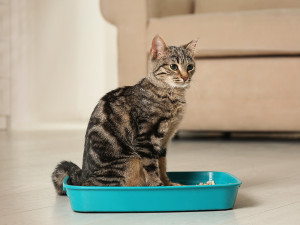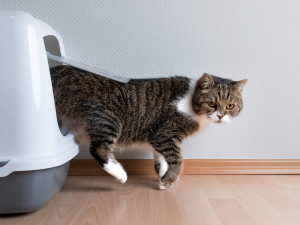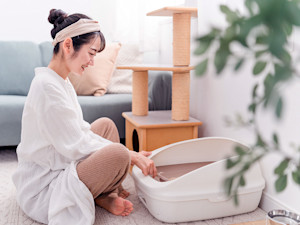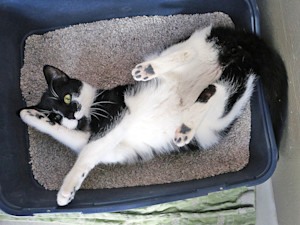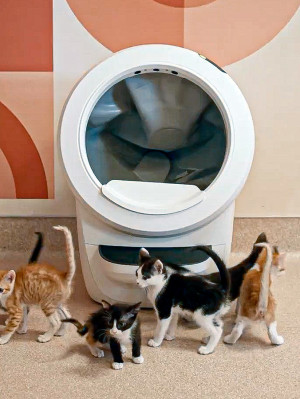Can You Put Baking Soda In Cat Litter?
Find out everything you need to know.

Share Article
In This Article
How Baking Soda Works in Litter How to Use Baking Soda in Litter Tips for a Maintaining a Fresh Litter Box Frequently Asked Questions
Keeping a litter box fresh and clean with minimal effort and expense takes discipline and dedication, as cat parents know. So it’s understandable that you’re tempted to reach for the box baking soda to help with odor control.
Experts agree small amounts of baking soda — a few tablespoons — mitigates unpleasant odors and isn’t dangerous for your cat.
Main takeaways
• Baking soda helps deodorize litter boxes and absorb urine.
• Using baking soda in cat litter is safe in small amounts.
How much do you spend on your pet per year?

• Experts advise using baking soda in litter that’s not dusty.
• Monitor you cat for sneezing and other signs they might be allergic to baking soda.
So, can you put baking soda in cat litter?
You can, and many people consider it one of the best pet-safeopens in new tab odor-busting, economical products out there. New York cat trainer and behaviorist Albert Colominasopens in new tab, founder of Outdoor Bengalopens in new tab, says baking soda is generally safe in small amounts and can be an effective way to help neutralize odors.
“Adding too much baking soda is not great because it creates more dust that gets everywhere, including the cat’s lungs,” Colominas says. “A light dusting mixed into the litter is plenty to help prevent smells.”
How baking soda works in cat litter
Mieshelle Nagelschneideropens in new tab, a certified cat behaviorist and owner of The Cat Behavior Clinicopens in new tab, used to work for Arm & Hammer as their international cat behavior expert. She says baking soda is dual action because it neutralizes pH and absorbs odor. “Baking soda works to absorb and neutralize odors through a chemical reaction that balances pH levels,” Nagelschneider explains. “Most odors in a litter box are caused by acidic or basic compounds, such as ammonia from urine (which is alkaline). Baking soda can react with both acids and bases. When baking soda comes into contact with these odor-causing compounds, it neutralizes them by balancing their pH.”
Nagelschneider says baking soda’s crystalline structure provides a large surface area to trap and hold odor molecules.
Colominas, who is originally from Barcelona, uses cooking as an analogy for baking soda’s pH balancing effect. “When I cook tomato sauce for my pasta, I do something similar. Tomatoes are naturally acidic. Adding a small amount of sugar to tomato sauce doesn’t remove the acidity, but it balances the taste by counteracting the sourness.”
How to use baking soda in cat litter
Using baking soda in cat litter is as easy as measuring and mixing. Before using it though you’ll want to consider what type of litter you’re using and how much baking soda to add. Then, keep an eye on your cats for any reactions.
Step 1: Buy the right type of litter
To offset the dust in baking soda, opt for cat litter with less dust. That might rule out some clumping litters. Adding baking soda to clumping litter might even increase adverse odors because both products have high pH levels that promote ammonia. Cat litter made from natural materials and agricultural byproducts like wood, paper and corn is the best choice to decrease dust. These litters have the added benefit of low pH levels (between 6.0 and 7.0) to offset the high pH in baking soda (8.4 or higher).
Step 2: Add the recommended amount of baking soda
18 x 15 litter box: 1-2 tablespoons baking soda
21.5 x 17.75 litter box: less than ¼ cup or 3 tablespoons baking soda
24 x 20 litter box: ¼ cup baking soda
Step: 3 Mix in the baking soda
Opinions vary here. Sprinkle a thin layer of baking soda on the bottom of the litter box. Or simply mix the recommended amount of baking soda directly into the litter with a clean scoop. Colominas says a light dusting mixed into the litter is plenty to help prevent smells.
Step 4: Monitor your cats
Watch your cat for sneezing, which means they might have gotten a nose full of dust. If your cat is prone to eating litter (a behavior called pica that’s fairly common) baking soda may cause vomiting, diarrhea, stomach pain, lethargy, incoordination, seizures and excessive water consumption. In rare cases, cats are allergic to baking soda and will develop an itchy rash. Swelling, dizziness, and trouble breathing are other signs of an allergic reaction.
Benefits of putting baking soda in cat litter
Colominas says baking soda helps control litter box smells and keeps the box drier, which makes it fresher.
Neutralize odors
Nagelschneider says years ago when non-clumping cat litter was commonplace and urine wasn’t trapped as easily, baking soda became a popular way to offset the smell of urine. “Now, with clumping litter, you can remove the urine out of the litter and the litter stays fresher longer and there’s probably less of a need to absorb the smell with baking soda. However, cats do have a bionic sense of smell, and baking soda could definitely be added as a best practice to further reduce litter box odor,” she says.
Save money on expensive deodorizers
In these uncertain economic times, it’s a relief to know baking soda remains a low-cost product. The average cost of a one-pound box of baking soda is $1.59.
Can buy it anywhere
Is there a grocery, gas or convenience store that doesn’t sell baking soda?
Drawbacks of using baking soda in cat litter
Can lead to health issues
Referring back to the science of baking soda, adding baking soda to high-pH litter might promote ammonia, which is harmful to cats’ respiratory systems. “Cats with asthma or existing respiratory conditions could be especially affected if too much is used,” Nagelschneider says.
Can increase dust
Galia Ivanova, the founder and CEO of Cleaning Estimate, a company dedicated to providing exceptional cleaning services to homes and businesses in the greater London area, has a professional interest in fresh-smelling litter. She also has several cats of her own.
She worries about the dust in baking soda. “One of my cats, an older fellow, started sneezing a lot when I tried it. If you do use it, a light sprinkle can help, but don’t go overboard,” Ivanova says.
Alternatives to baking soda for litter box odors
Ivanova keeps a small air purifier in the room with the litter box. “That’s been more effective than any scented additive,” she says. “There are commercial deodorizers made specifically for cat boxes, and if it’s unscented or lightly scented, it’s usually better tolerated.”
Charcoal
“Charcoal filters or a good quality odor-trapping mat placed near the box can do wonders,” Ivanova says. Nagelschneider has run litter box studies at her clinic and has found that litter containing charcoal was used much more frequently by cats than litter not containing odor-absorbing charcoal.
Essential oils
Ivanova does not recommend essential oils as they’re overpowering to cats. “Some are actually toxic to cats,” she says.
Commercial cat litter deodorizers
Options abound in this category. Often once you’ve cleaned vomit, pee or poop off the floor, you want to spray the spot with something fresh-smelling. Those who know, know. It’s a psychological thing. The same urge can apply to using cat litter deodorizers. There are lot of great commercial cat litter deodorizers and pet odor eliminatorsopens in new tab out there but for the litter box, avoid artificial scents.
The same goes for scented litters, Nagelschneider says. “There are so many scented litters on the market and I think they can be a huge deterrent for cats yet the unscented litters don’t really seem to address odor. I believe if cat owners stopped using scented litters and used unscented litters and then added baking soda we might actually have fewer litter box issues with cats. Cats really do prefer clean smelling boxes,” she says.
Tips for maintaining a fresh litter box
Colominas is something of a litter box evangelist. “The best way to keep a litter box odor free is to use a good litter and to clean regularly,” he says. He recommends World’s Best Cat Litter. “It’s amazing at controlling smells and very easy to clean.”
Colominas recommends sifting your litter box every day and deep-cleaning once a week. Remember, no product can replace a regular cleaning schedule (except maybe a self-cleaning litter box and those still need maintenance). Along with deodorizing litter boxes, baking soda doubles for cleaning litter, poop and pee stuck to the bottom of the box. Make a paste of baking soda and water and maybe a splash of white vinegar, get some gloves and get scrubbing!
Nagelschneider recommends uncovered boxes. “Covered (meaning hooded) litter boxes trap the airflow and create a porta-potty effect and can undermine all of your best litter box practices,” she says.
Final thoughts: Using baking soda in your cat’s litter box
Nagelschneider says she doesn’t think there’s any risk of using baking soda sprinkled in the litter box and she thinks it is effective. “I just would not want it to take the place of an owner scooping the box one to two times daily,” she says.
FAQs
Can baking soda harm my cat?
Baking soda is toxic to cats if they ingest it directly, which is why you’ll want to put the box of baking soda away after using it. Boxes, as cat parents, know are highly tempting to tip over. Cats may also inhale baking soda. “It can make more dust, bother sensitive cats, or change the smell and feel of the litter, which some cats might not like. I would try just a little bit at first and level up if the cat doesn’t care and you like the results,” Colominas says.
How often should I add baking soda to cat litter?
To maintain the recommended amount, add baking soda each time the litter is completely changed. Don’t be tempted to sprinkle it in each time you scoop the litter as you might end up with too much baking soda in the box.
How to make cat litter deodorizer?
For litter receptacles beneath automatic litter boxes that cats don’t touch, some cat parents like to sprinkle a mix of baking soda and a few drops of essential oil. Additionally, activated charcoal traps litter box odors instead of masking them. Natural enzyme-based cleaners are another non-toxic option.

Catherine Fahy Green
Catherine Fahy Green is a journalist turned copy and content writer. As a pets writer, she focuses on and is fascinated by animal body language because there's so much to learn from and about animals by spending time in their presence and observing their physical cues.
Her work as a PR specialist appears in national trade media as press releases and stories about exciting new products people should try. She lives with her family in Western Massachusetts, where she listens closely to the stories her two dogs, flock of chickens, and four horses tell her. She spends her weekends at horse shows with her daughter.
Related articles
![two cats sharing litter box]()
Can Cats Share a Litter Box?
The better question is should they?
![cat coming out of litter box]()
What to Do When Your Cat Refuses to Be (Litter) Boxed In
An expert explains why kitties are so particular about where they pop a squat.
![Woman cleaning cat's litter box.]()
How to Clean a Litter Box
Cats appreciate a clean bathroom as much as you do.
13 Reasons Why Your Cat Is Peeing Outside the Litter Box, and How to Fix It
Our experts reveal why this might be happening.
![Funny black and white cat laying in litter box.]()
Why Is My Cat Chilling in the Litter Box?
Here are four reasons why the litter box is your cat’s new favorite spot.
![Kittens and the Litter Robot kitty litter box.]()
The Best Litter Boxes for Kittens in 2025
Help your little one learn the ropes.
